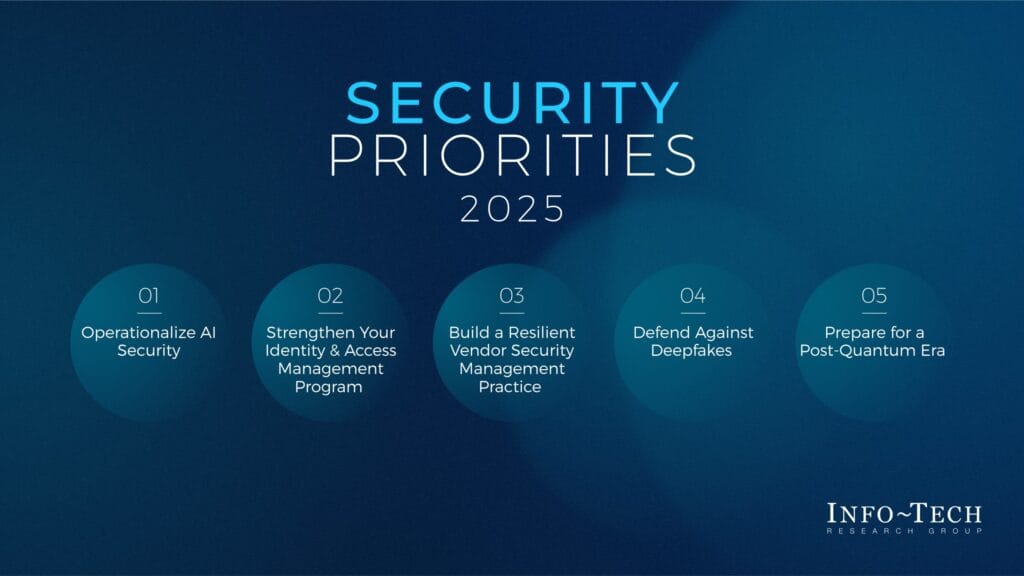In a world where cyber threats are evolving at an unprecedented pace, the Info-Tech Research Group has released its annual report Security Priorities 2025, highlighting key strategies for cybersecurity leaders to protect their organizations and adapt to the emerging landscape. This report underscores how to operationalize AI-driven security, strengthen identity and access management (IAM), and prepare for the challenges of the quantum future.
Cybersecurity in Transformation
The report emphasizes that the rise of sophisticated attacks, driven by artificial intelligence (AI) and advancements in quantum computing, is forcing organizations to shift from a reactive approach to proactive strategies. According to Ahmad Jowhar, senior analyst at Info-Tech and author of the report, “Cybersecurity leaders must not only defend against threats but also adopt innovative and anticipatory measures that integrate security into the core of their business operations.”
The report is based on extensive research, including the Future of IT 2025 survey and interviews with industry experts, providing companies with a practical framework to align their security strategies with broader business objectives.
Five Key Security Priorities for 2025
- Operationalize Security with AI
- The rapid adoption of AI requires responsible governance to mitigate security and privacy risks. Implementing clear policies and assessing potential vulnerabilities will be essential steps in leveraging AI for security operations.
- Enhance Identity and Access Management (IAM)
- As identity-based attacks increase, modernizing IAM programs is critical. Zero-trust security models, risk-based authentication, and continuous verification are key tools for protecting sensitive assets.
- Build Resilient Vendor Security Management Practices
- Third-party risks are an increasing concern. The report recommends risk-based assessments, continuous monitoring, and collaboration with stakeholders to strengthen supply chains.
- Defend Against Deepfakes
- Deepfake technology poses a significant threat. Organizations must invest in detection tools and policies to verify suspicious activities and protect critical assets.
- Prepare for a Post-Quantum Era
- Quantum computing represents a long-term threat to current encryption methods. Developing quantum-resistant cryptographic strategies and conducting risk assessments will ensure organizations are ready for the impact of these technologies.
Adaptation and Innovation: Keys to the Future
The report highlights the importance of integrating cybersecurity into organizational strategy as a driver of both innovation and risk mitigation. As the cyber landscape becomes more complex, opportunities to optimize operations, protect assets, and enable sustainable growth also increase.
Jowhar emphasized: “Cybersecurity is not just about defense; it’s an opportunity to lead with resilience and innovation.”
Persistent Challenges
Despite the optimism, significant obstacles remain:
- Lack of talent: 40% of respondents identified a shortage of qualified professionals as a major limitation.
- Insufficient budgets: 37% cited financial constraints as a barrier to implementing advanced solutions.
These limitations reflect a market where demand for experts in areas such as KubernetesKubernetes (commonly referred to in English as “K8s”) …, serverless architectures, and cloud security exceeds the available supply.
Looking Ahead
The report concludes that by 2025, the integration of AI and advanced cybersecurity strategies will be essential to address emerging threats. Initiatives such as advanced threat detection and AI-enabled services rank among the top priorities for organizations.
About Info-Tech Research Group:
With nearly three decades of experience, Info-Tech is a global leader in IT research and advisory. Its mission is to provide tools and strategic guidance to help organizations thrive in a dynamic technology environment.
via: Prnewswire

